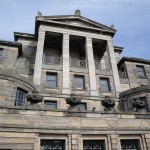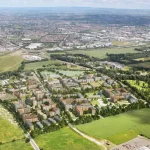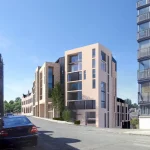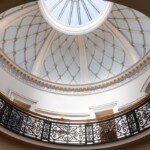The List, Future Edinburgh Architecture, Scottish Magazine Article, Buildings Scotland
List Article: Cranespotting Edinburgh Architecture
The List Magazine : Article by Adrian Welch, Architect, Scotland
Intro
This article has been written by Adrian Welch of www.edinburgharchitecture.co.uk and looks at some forthcoming schemes with a major impact on our city. The views expressed are my individual ones and do not necessarily represent the collective view of www.edinburgharchitecture.co.uk.
The website is local, unfunded and independent. It aims to provide locals – as well as architects – with information on their built environment.
The List Magazine Article
Jeffrey Street Project
Client: EDI
Architect: Allan Murray Architects
Status: Planning Permission awaited
So little a site, so great a debate. At around 1/8 of an acre, this empty central site is minuscule compared to the New Street Bus Station scheme, but has provoked the usual flurry of protest nonetheless.
The architecture is certainly considered, but blocks the cherished view of Calton Hill from much of Jeffrey Street and St Mary St: it has even spawned a website campaigning to ‘save the view’.
I am strongly in favour of considered contemporary interventions inserted into what is now a World Heritage Site. Like the Edinburgh Science Centre project nearby on Market Street, the expanses of glass will stand out amongst the intricately-decorative weathered stone of the Edinburgh Old Town spine’s north face: this is either good or bad depending on whether you are a preservationist or a modernist. A skilful architect should surely be able to insert a crafted jewel that pleases both: zeitgeist with no breakages. But then, this is Edinburgh after all.
I would therefore be a natural supporter of this scheme, with its refreshingly asymmetric, curvaceous form and dual public stairs threading through (see the model at 1 Cockburn Street): but after much walking around the site, I see the passing away of the view as regrettable.
The height doesn’t bother me – it oozes ‘landmark’ – but why not cut a vista through at street level, provide a ground-floor café (on Jeffrey Street) or even a publicly-accessible roof terrace? Transformation becomes polarisation: privatisation of space saves the views for the few. As for the refurbishment of the arches (the nascent arts quarter), this is clearly excellent as an overdue reinvigoration of East Market St, and fantastic as the perfect PR smokescreen.
Ocean Terminal
Client: Forth Ports Plc & the Bank of Scotland
Masterplan Architects (Leith Docks): Conran & Partners
Architects (Ocean Terminal): Conran & Partners; Keppie Architects
Status: Planning Permission granted, on site, due to be completed October 4th.
Please Terry, can we have some better buildings? Leith Docks: a huge money-making machine, or an area attaining maximum architectural potential? I think the former. Mostly owned by Forth Ports plc (Terry Smith is their Property Director) the Docks form one huge building site.
Just look however at Tower street flats (near the top in the recent Carbuncle Awards), the toy-town shed of Scot FM, and, the cherry on the top, the Holiday Inn with its appliqué half-lemon fanlight. These turgid buildings drag the area down, but at least are unseen from afar.
Step forward the Ocean Terminal. This hulk of a building sticks out like a beached whale from Arthur’s Seat: so huge, that it is set to increase Edinburgh’s retail area by 25%. It is a bizarre building. Why? Well firstly it adopts the monolithic form of the Scottish Executive Building, rather than a more contextual (don’t even attempt to explain it away with reference to Patterson’s warehouses) ‘broken down’ approach.
Not content with this brutish – but efficient – form, the building turns to line the quay and jars with the other ‘liner’ berthed at Victoria Quay. Secondly it greets its guests with one of two multi-storey car parks, which form symmetrical bookends. Thirdly, the rotunda, which aimed to be a crowning beacon, is now a lost stump, cowering behind various bits of roofscape.
Finally, and most worryingly, the Terminal turns its back on the waterscape. Views to Fife there may be, but access to the dockside is forbidden unless you drive an articulated truck or are visiting Britannia. Partly due to security for Britannia (which will be moved – with its exhibition – to a berth in front of the Terminal), it’s not hard to imagine a better solution. Yet another sad example of Edinburgh neglecting its boundary with the sea.
Granton Waterfront
Client: Waterfront-Edinburgh Ltd.; Lattice Property; Forth Ports Plc
Masterplan Architects: Llewellyn-Davies
Architects: various
Status: Masterplan approved; Various Planning Permissions & Listed Building Consents requested/granted, some buildings on site
One-billion-pound budget, possible World Trade Centre and landmark gasometers, all by the sea: the phrases ‘promising context’ and ‘internationally significant’ spring to mind.
Let’s hope Edinburgh can pull this one off (let’s face it, the relationship with the sea at present is generally a disaster area). The site in North Granton comprises of both active and disused industrial sites – mostly ugly anonymous sheds. Interspersed are some noteworthy elements:- the world’s first purpose-built car factory (Madelvic), the site of the world’s first roll-on-roll-off ferry, historic Granton Square, Caroline Park, two yacht clubs and a landlocked lighthouse, not to mention three gasometers that act as landmarks for Edinburgh from afar.
Anyone confused by the project should read Andrew Russell’s interview on www.edinburgharchitecture.co.uk, but, in passing, it’s notable that all the gasometers were proposed to be demolished, though the central one is listed: rumours suggest this may now be saved. What a waste of potentially great space: anyone with good ideas for re-use should contact www.edinburgharchitecture.co.uk and maybe we can get the ball rolling. Just like the Jeffrey Street scheme, there is a website campaigning against the proposals, operated by one of the yacht clubs.
It is hard to comprehend a project so large, but two things are certain. Bordering some of Edinburgh’s poorest estates and being on the city’s edge mean adequate social housing provision, sufficient and integrated public transport are a must. The developers cannot afford to fudge this one, or they’ll end up with more than a yacht club on their backs.
The Exchange
Client: various
Masterplan Architects: Terry Farrell & Partners
Architects: various
Status: Masterplan approved; Various Planning Permissions requested/granted, most buildings completed, some on site
Ceaucescu Plaza was how Murray Grigor (my accomplice in ‘Edinburgh on the Rack’) described it: Festival Square is the soulless void that until recently tried vainly to be The Exchange’s centrepiece. It is of course anything but a festival in this square, apart from a brief splash of colour courtesy of architects-of-air at this year’s festival: this massive inflatable was too much for the Sheraton Hotel who complained that it spoilt the view (how ironic).
The Exchange was masterplanned by Terry Farrell & Partners: they have an Edinburgh office, but are based in London. The architects’ masterplan aimed to fill the disused goods yard – to the south of the former railway hotel, The Caledonian – with high-density office blocks.
These have varied from Croydon-meets-Dallas at Baillie Gifford to pompous neo-classical at Standard Life and Clydesdale Bank, which face each other across the barren chasm of the Western Approach Road. More recent buildings such as the EICC The Exchange and Scottish Widows have made a slight improvement, though these blockbusters-on-steroids do show considerable flaws. Terry Farrell himself complained – with no hint of irony – on a recent trip to Edinburgh that the quality of some buildings on his patch left a lot to be desired.
Festival Square’s new sibling – Conference Square – is more organic, but lacks focus and sense of place. In summary The Exchange is good for business, but not for architecture. Recent glimmers of hope are offered by those eclectic Rogues at Scottish Widows and the pleinair joys of the Sheraton Health Club Pool. However there is no accounting for taste: if you like re-heated neo-classicism and overblown pomposity, this could be your Mecca.
Calton Square & omniedinburgh
Client: Pillar Property for Eton House & Baillie Gifford; Warner Village Cinemas
Architects: Allan Murray Architects ; The Parr Partnership
’Where’s the view of the sea gone?’ exclaimed my wife coming down Leith Street recently, amazed at the speed of construction on this site.
The eyesore of concrete reinforcement that used to sprout from concrete paddy fields has been harvested: views to Calton Hill and Leith Walk (se Leith Gateway) are now severely limited. Leith Street used to be one of the rougher parts of town, known for seedy drinking holes and dens of iniquity. Although one can hardly imagine Warner Villages re-capturing this flavour, it makes sense to revitalise the area between theEdinburgh Playhouse and Princes Street Shopping: an empty ‘link corridor’ will be gladly lost.
The site has been disused for around thirty years, and, like the hole filled in by Saltire Court, building here patches an unfortunate gap in the city’s built environment. The western section takes the form of offices by Allan Murray with what is becoming a trademark prow acting as a landmark facing up Leith Street: Baillie Gifford are due to take up a large proportion of these premises.
The eastern site by the Playhouse is of course the 12-screen Warner Villages Vue Edinburgh Cinema, with a £7m hotel, restaurants, health club and a nightclub to boot. One key aspect of the scheme will be the view down from Calton Hill: it’s too early to judge this, but let’s hope that Calton Square can help ameliorate the visual damage done by the New Town St James Centre.
Comments / photos for The List Magazine Article – Cranespotting Edinburgh Architecture page welcome



